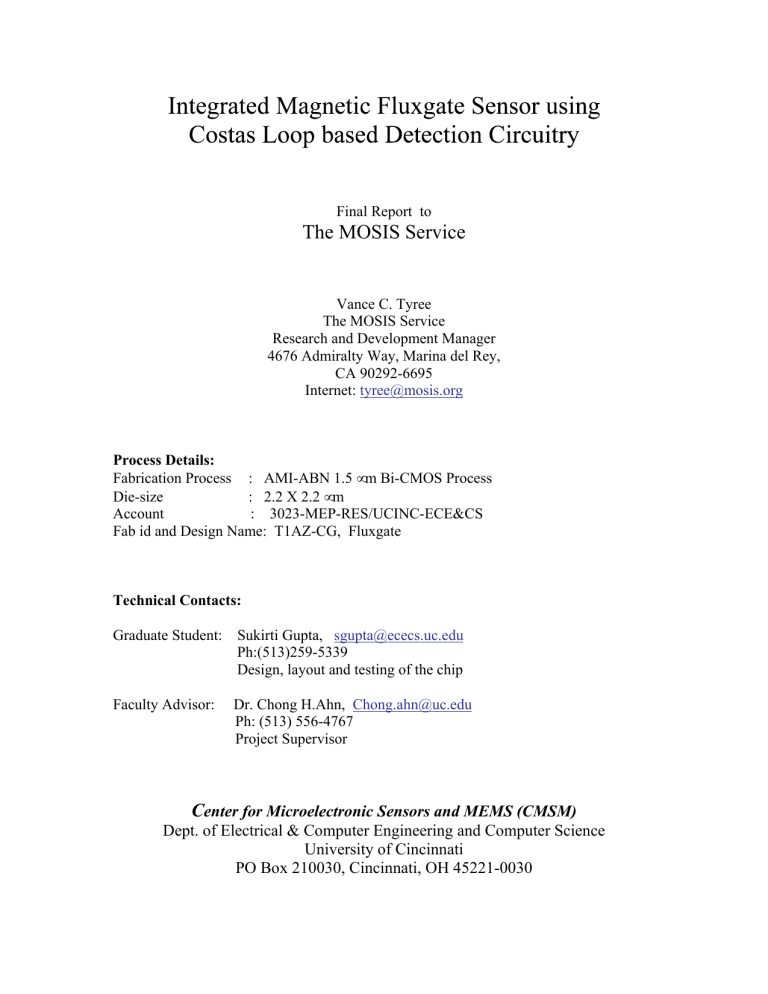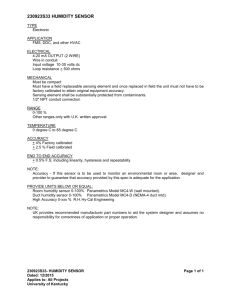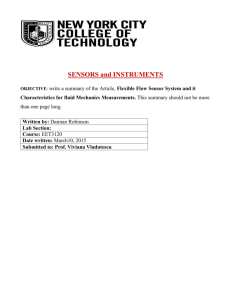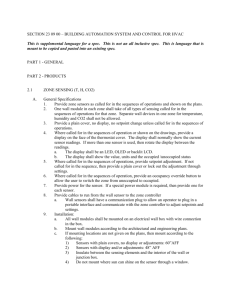Report - Mosis

Final Report to
The MOSIS Service
Vance C. Tyree
The MOSIS Service
Research and Development Manager
4676 Admiralty Way, Marina del Rey,
CA 90292-6695
Internet: tyree@mosis.org
Process Details:
Fabrication Process : AMI-ABN 1.5
µ m Bi-CMOS Process
Die-size : 2.2 X 2.2
µ m
Account : 3023-MEP-RES/UCINC-ECE&CS
Fab id and Design Name: T1AZ-CG, Fluxgate
Technical Contacts:
Graduate Student: Sukirti Gupta, sgupta@ececs.uc.edu
Ph:(513)259-5339
Design, layout and testing of the chip
Faculty Advisor: Dr. Chong H.Ahn, Chong.ahn@uc.edu
Ph: (513) 556-4767
Project Supervisor
C enter for Microelectronic Sensors and MEMS (CMSM)
Dept. of Electrical & Computer Engineering and Computer Science
University of Cincinnati
PO Box 210030, Cincinnati, OH 45221-0030
Project Overview:
The main objective of this project was to design and test an ASIC containing excitation and sensing circuit for the fluxgate sensors. In this work, we wanted to analyze a new output signal processing technique and to compare it with the conventional sensing scheme. In the next stage of the project we would post-fabricate the sensors over the sensing chip by using UV-LIGA based CMOS compatible fabrication techniques.
In the present chip we have successfully designed and tested all the components required for the conventional and our new approach. A brief description of conventional and our costas loop based sensing approach is as follows:
Working Principle:
In the fluxgate sensor, for external magnetic field measurement, it is compared with an excitation field, which is used as a reference. So for implementation of an integrated sensor we need excitation circuit as well as sensing circuit.
Sensor excitation circuit is required to generate the reference field. Fluxgate sensor operates in two different modes: saturation mode and non-saturation mode. In the saturation mode, sensor magnetic core is saturated by the excitation waveform and it completely blocks the external magnetic field. During non-saturation mode, external field passes sweeps through the core as it offers low reluctance path. This change in flux through the sensing coil, generates the sensor output and it can be shown that second harmonic of this output is proportional to applied external magnetic field, i.e. if the excitation field has a frequency fo, and the sensor is exposed to the external magnetic field, sensor output is a DSB (double sideband modulated) modulated signal and the second harmonic of the sensor output (2fo) is proportional to the external magnetic field.
Conventional Sensing Approach:
In the conventional sensing circuit, this second harmonic is extracted by multiplying the sensor output with twice of the reference excitation signal and passing the output through a low pass filter. The basic assumption involved in this demodulation technique is, there is a constant phase difference between the sensor output and the reference excitation signal. This assumption is not very true for fluxgate sensors as in this case sensor output is generated by a variable inductor (core saturated: low inductance, core non-saturated: high inductance) and hence the phase difference between the reference signal and the sensed output is not fixed.
Block diagram of the conventional sensing scheme is shown below:
Clock
Generator
Clock Generator
(2fo)
Excitation Coil
Sensor
Sensing Coil
Clock Divider
(divide by 2)
Power
Amplifier
Cross
Switch
Low Pass Filter
Synchronous Detector
Output Amplifier
Conventional Fluxgate Sensing Circuit
Costas Loop Based Sensing Approach:
In the proposed circuit, for the first time we are using Costas loop based receiver, which automatically takes care of this variable phase difference by extracting the control signal of the voltage controlled oscillator (VCO) from the difference of in-phase and quardature-phase components. This VCO output is used as a reference signal for the extraction of the second harmonic of the sensor output. Block diagram of the costas loop based sensing approach has been shown below:
Sensed O/P
Fluxgate
Sensor
Current
Amplifier
X
VCO
LPF
Sub tractor
O/P
Excitation (reference) I/P
Current
Amplifier
90 o phase shift
X
Costas Loop
LPF
Desired Frequency Range:
For this ASIC, we were interested only at the low frequency operations as the noise generated in the magnetic core at high frequencies adversely affects the sensitivity of the sensor. Also as the core is periodically saturated in two opposite directions, it is hard to achieve complete saturation at higher frequencies, because of low speed of domain wall movement. Because of above-mentioned reasons, we have designed the complete circuit for 5 Khz to 50 Khz of excitation frequency.
Components Required:
• Clock Generator: It is required for generation of excitation waveform. In this chip,
Schmitt trigger based multi-vibrator has been used to generate square waveform. Schmitt trigger input and output has been connected to external pins, so that generated frequency can be changed by changing the resistance and capacitance in the feedback loop.
• Op –amp: Two op-amps have been integrated for the realization of low pass filter as well as amplifier.
• BJT Current Amplifier: High excitation current (~ 10 mA) is required to completely saturate the core. BJT current amplifier has been used to generate this high current.
• Phase sensitive detector: Pass transistor based phase sensitive detectors have been used to extract the second harmonic from the sensor output in conventional approach.
• Voltage Controlled Oscillator: Voltage controlled oscillator has been implemented for the realization of Costas loop.
All the above components were connected to external pins and can be tested externally.
90 o
phase shifted component of the VCO output was generated internally by applying the
VCO output and its half frequency component (by D flip flop) to Ex-OR gate.
Sensor input can be applied to cross switches ( for costas loop based sensing scheme) and phase sensitive detector ( for conventional sensing scheme) by analog I/P pins, which are connected to these components. Magnetic sensor required for this work is under fabrication.
Clock Generation Circuit
R = 556 K, C= 2.2 nF, Frequency = 735 Hz
R = 356K, C= 0.4 nF, Frequency = 2.2 K. Hz
C = 47 pF, R = 100 K, Frequency = 7.51 M Hz.
Appropriate clock output was obtained till 1 Mhz, which suffices our purpose.
OP- AMP
Buffer Circuit: Input = Output, Frequency = 100 K Hz
Op-AMP Amplifier Circuit:
Vin = 171 mV, Vout = 625.0 mV, Frequency = 300 K.Hz.
Transistor Gain = 104
BJT Testing
Vertical Axis:
Left hand side: Ic ( Collector Current) = 500
µ
A/ div.
Right hand Side: Ib (Base Current) = 2.14
µ
A/div
Horizontal axis:
Vce (Voltage between collector and emitter)
Schematic
Phase Sensitive Detector
Measurement Results:
When clock and the input are the same: Complete rectification is achieved
Triangular waveform:
V
V o1 o2
PSD output = V o1
– V o2
= 5V peak to peak rectified signal (complete rectification)
Sinusodial waveform:
When clock is 5 Khz. & Input is 5.5 Khz.
Frequency = 1 Khz.
Frequency = 10 Khz.
Vpp = 5V
Vavg = 50.6 mV
Schematic:
VCO
External capacitances = 0.34 nF
Measurement Results :
V control = -1.1 V
Frequency = 90 Khz.
V control = 0.4 V
V control = 4.4 V
Frequency = 141 Khz.
Frequency = 165.6 Khz.
Conclusion: In this work, components required for conventional sensing scheme as well for Costas loop based sensing scheme for fluxgate magnetic sensor, have been successfully designed and tested. All the components are working fine in the desired frequency range, though some distortion has been observed at higher frequencies.








